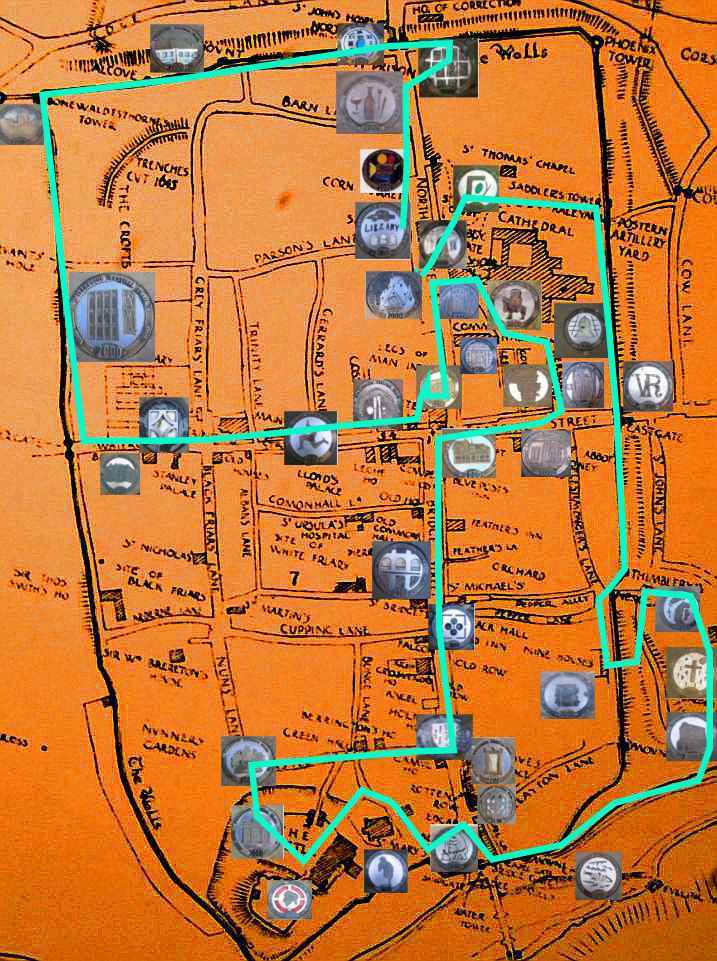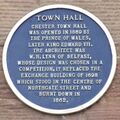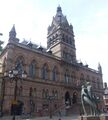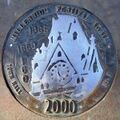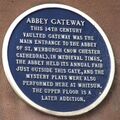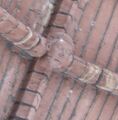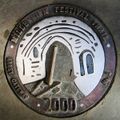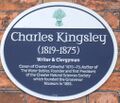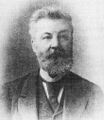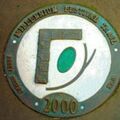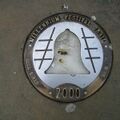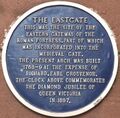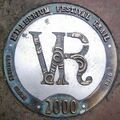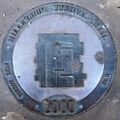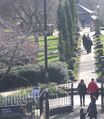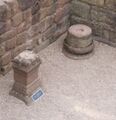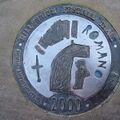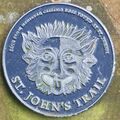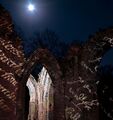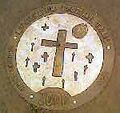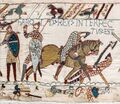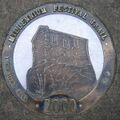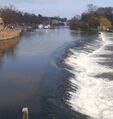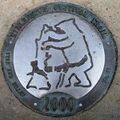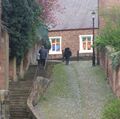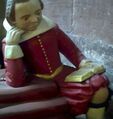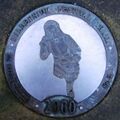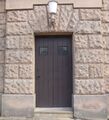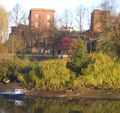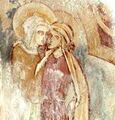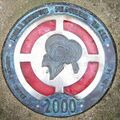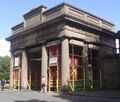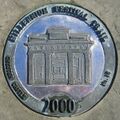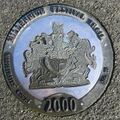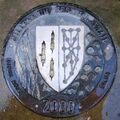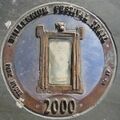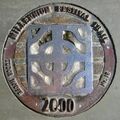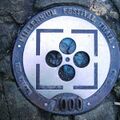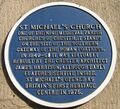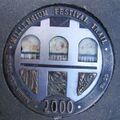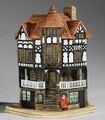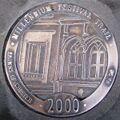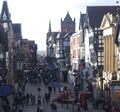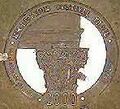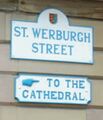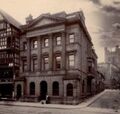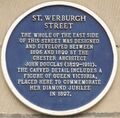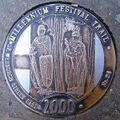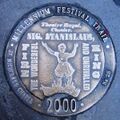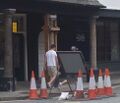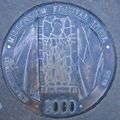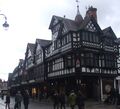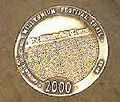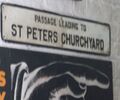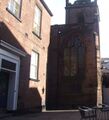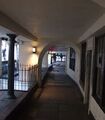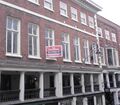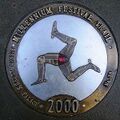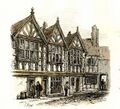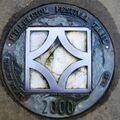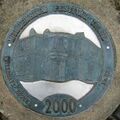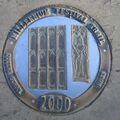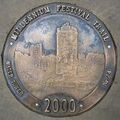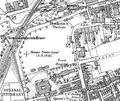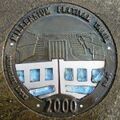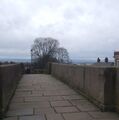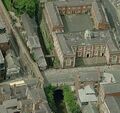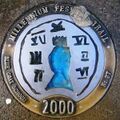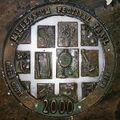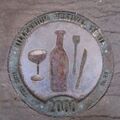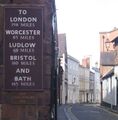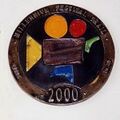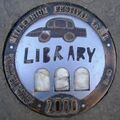Millennium festival trail
All 40 buildings on the Millennium Trail were selected by local people as outstanding examples of Chester’s architectural development over two millennia, from Roman Chester to the present day. Each building is celebrated with its own unique "way-marker", created by artist Michael Johnson. The complete route is approximately 3 miles (5200m) long and can take anything about 2-5 hours, depending on detours and pubs (it also takes in most of the main shopping streets). The trail begins and ends at Chester Town Hall and Tourist Information Center. Look for the way-markers set in the ground: they are about 30cm across - but beware, some of them can be quite hard to find!
The route is not suitable for wheelchairs and prams as there are lots of steps and one remarkably steep street.
- Millennium Trail at the Civic Trust;
- Chester Tourist has a detailed guide to the trail with very many photographs of details to watch out for.
- A Chester Lightning Tour - work in progress: the best sites of Chester in one day (not suitable for wheelchair users);
- The Mystery Tour
The Millennium Trail Map
Here is ChesterWiki's own guide to the Millennium Trail, with some extra locations and side expeditions added. If you "mouse-over" on the way-markers then you will see what the building is, and if you click then you will be taken to whatever information there is on ChesterWiki about the building.
The Millennium Trail (and a few extras)
The Civic Trust did a marvelous job with the Millennium Trail, but we could not resist the urge to go one better and add some more stops along the way and a few, optional "side adventures". If there is a link in the title then you can follow it to find a Chesterwiki reference with more information, such as the page on the Town Hall, etc.
Start at the Tourist Information Office by the Town Hall in Northgate Street

This starts at the Town Hall and it is either open to the public or shut. If the Town Hall is open to the public then the inside is worth seeing, especially for the stained glass depictions of the Earls of Chester, some paintings, the original Magistrates Court and a few little things like the portrait of Owen Jones. You could spend half an hour in here at least looking at all the details.
The Blue Plaque at the Town Hall;
The place to start. The Town Hall is often open to the public - free of charge.
The stained glass depicts the Earls of Chester
Officially opened on 15 October 1869. On 27 March 1897 the council chamber on the second floor was gutted by fire; it was restored by T. M. Lockwood the following year. In 1979 a clock was installed in the tower with three faces; there is no face on the west side of the tower.
- Town Hall at English Heritage;
- Town Hall on Wikipedia;
- TRIVIA: A History of the Police Station at the Town Hall;
Cross the square to the Abbey Gateway

Don't miss the elephant!
The gateway was built as a gatehouse around 1300 and its upper storey was rebuilt around 1800. It is thought that the architect was Richard Lenginour (Richard the Engineer).
- Abbey Gateway at English Heritage;
- Abbey Gateway at Wikipedia;
Pass through the gateway to reach Abbey Square
John Douglas had his office at No.6
Cottages built by Bishop John Bridgeman in 1626
This elegant square was built in the mid 18th Century on the site of the Abbey Bakehouse and Brewery. The column in the central garden is said to have come from the old Exchange building in 1756 (it probably wasn't).
- The Cross at English Heritage;
- The Cottages at English Heritage;
On the opposite side of the square take cobbled Abbey Street down to Kaleyard gate and get up onto the walls. Follow the walls along to the Bell Tower
..not the same "Nora Batty"
See the carving in the Wall which represents the length of the Great Eastern
1969 - the bells are removed from the Cathedral;
In February 1969, nine of the ten bells in the central tower were removed to be recast by John Taylor & Co as a ring of twelve bells with a flat sixth. The new bells were cast in 1973 and work on the new bell-tower began in the same year. Two old bells dating from 1606 and 1626 were left in the tower. On 26 February 1975 the new bells were rung for the first time, the official opening was on 25 June 1975. A now almost unique feature of the bell-tower is that the soffits above the door and windows are made of "lead coated steel" an innovation put into production at Chester's Leadworks. This was for cladding of buildings with rust free external panels and was a fore-runner to the cheaper plastics/aluminium panels which were used more recently (to disasterous effect due to flammability). These innovative lead/steel panels were more visible on the mansard roof of "Windsor House", an office block (with shops on the ground floor) of 1974-5 by John Taylor of Edmund Kirby and Partners, at the corner of Pepper Street and Lower Bridge Street - but they have been removed during renovations in 2018. The panels are manufactured by rolling together pre-treated steel sheet and lead sheet with sufficient force to ensure cohesion without the need for adhesive. The sandstone base of the tower is also of local origin while the slates are from Bethesda in North Wales.
- Bell Tower at English Heritage;
- Bell Tower on Wikipedia;
- Jeff Buck's picture from the top of the Cathedral;
Continue along the walls and up the steps to the Eastgate Clock
Do not miss the gravestone hidden in the wall.
The building with the arms has a memorial to Owen Jones;
Watertower on site from where water was supplied to Roman Chester;
The "new" gate which was erected 1768-9 at the expense of Richard, then Lord Grosvenor and (supposedly) designed by Joseph Turner. The Eastgate clock (designed by John Douglas) commemorates the Diamond Jubilee of Queen Victoria (1897) and was unveiled on the 24th May 1899.
Stay on the City Walls until just after the Wolfgate and Newgate then leave the Walls and walk down Park Street to the Nine Houses
The Wolfgate has an amusing legend;
Listen to the audio recordings in the two chambers on the Newgate;
Note the statue of a lion;
Note the house with "Fountain of Life" inscription;
The houses are the only surviving pre-16th-century almshouses in Chester. They were built in about 1650 (as part of the restoration of Chester following the Civil War) and extensively repaired and renovated in 1968-9. They are not the "oldest council houses" in the country - the first recorded almshouse was founded in York by King Athelstan; the oldest still in existence is the Hospital of St. Cross in Winchester, dating to circa 1133.
- Nine Houses at English Heritage;
- Nine Houses on Wikipedia;

Go through the gate in the walls and through the Roman Gardens, then turn right to reach the Amphitheatre
then cross to the Amphitheatre
Replica Nemesis Altar (original in the Grosvenor Museum);
The remains were discovered in June 1929 by amateur archaeologist W J "Walrus" Williams (1875-1971), while examining a pit dug (in the cellar of an Ursuline Convent) for the installation of a heating system. Excavation began in 1939 but was halted at the outbreak of WW2, and did not resume until 1957. The Victorian Dee house, which covered part of the site, was demolished in June 1958 and excavation commenced in 1960. The Amphitheatre was eventually opened to the public in August 1972.
- Amphitheatre at English Heritage;
- Amphitheatre on Wikipedia;
- The Amphiteatre on "Cheshire Now";

Cross to the other side of the Amphitheatre, and head towards St Johns Church
If St Johns is open (generally after 10:00) then the inside is well worth a visit - it is often called "Chester's hidden gem" and even if you are not a "church" person the atmosphere is very historic and a lot of effort has gone into signage explaining what everything is. Obviously, time your trip to avoid services. They also do the cheapest cup of tea in Chester.
St Johns has spectacular ruins at both ends;
St John's hosted a famous trial - witnesses included John of Gaunt, Geoffrey Chaucer and Owain Glyndŵr;
The West Tower fell down on Good Friday in 1881;
New life springs from the famous "Coffin in the Wall"
Tradition ascribes the foundation of St. John's to Æthelred, king of Mercia (674–704), in 689. In 906, the Abbey of St John the Baptist was founded by a later Æthelred, Earl of Mercia. In 1075, Peter de Leia, bishop of Lichfield removed his episcopal see to Chester: the old St John's just would not do as the home of an important bishop, and so had to be rebuilt. In 1085 De Leia died and his successor Robert de Limesey translated his see from Chester to Coventry. The full article on St Johns charts its remarkable history and refusal to simply fade away.
- Parish of Chester history page - their own page;
- Chesterwallsinfo on St John;
- Pastscape - the English Heritage page;
- St Johns on Wikipedia;
- Gravestones at St John's;
From the ruins at the far end of St Johns church head down the slope towards the River Dee and the Hermitage
Ahead is the Suspension Bridge where the coats of arms appear mixed-up;
On the right is Grosvenor Park (with some relics including Jacobs Well);
Detail from Jacobs Well;
The Hermitage - local legend says that one hermit was....

One of the most unusual buildings in Chester is the Anchorite's Cell or 'Hermitage', a small sandstone building by the River Dee. The present building is believed to date from the mid 14th century and was one of two 'cells' built as religious retreats for reclusive monks or hermits. Until the reformation it belonged to the collegiate Church of St Johns.
Turn right and walk along the River Dee towards the Norman Weir and the Old Dee Bridge
If you have the time, cross the river to visit the Minerva Shrine;
The buildings across the River Dee used to include the Mill Offices
The Old Dee Bridge
Cross the Old Dee Bridge for a view of the Grosvenor Bridge;
Originally the site of a causeway across the River Dee. The weir was built in sandstone in 1093 for Hugh of Avranches. It was designed to provide a head of water for the medieval mills on the river. The mills were demolished during the 20th century and the weir was restored to serve the Chester City Council's hydro-electric power station, which operated from 1913 to 1939.

- Chester Weir at English Heritage;
- Chester Weir on Wikipedia;
Enter Bridgegate and arrive at the Bear and Billet
- Perhaps its time for a drink!
The Bear and Billet was built in 1664 as the Bridge Street town house of the Earls of Shrewsbury who held the hereditary serjeancy of the nearby Bridgegate. It was possibly, given its proximity to the Dee Mills used as a grain warehouse (in the gable are double doors and a bracket for a hoist). The building became an inn in the 18th century, although it continued to be owned by the Shrewsbury family until 1867. Its name is taken from the heraldic device of the Earls that consist of a bear tied to a billet (or stake). In the Batenham illustration it is called the "Bridgegate Tavern".
- Bear and Billet at English Heritage;
- Bear and Billet on Wikipedia;
Walking past the Bear and Billet take the first right (Shipgate Street) and walk down to the end. On the right you will see a steep street rising up the hill. Climb up the hill to reach St Mary on the Hill.
Unfortunately, St Mary on the Hill is not normally open for visitors, which is a pity, because the inside is very spectacular.
- St Mary on the Hill, at English Heritage;
- St Mary on the Hill, on Wikipedia;

Cross the Chester Castle car-park. At the far end is a barred gate. That is as close as you can get to the Agricola Tower these days.
The Courts and Prison were designed by Harrison
John McCafferty - last man to try to take the Castle
- Agricola Tower at English Heritage;
- Agricola Tower on Wikipedia;
Head for the Castle gateway.
The Military Museum is just here.
- Chester Castle on Wikipedia;
From the Castle gateway head up the road past the equestrian statue
The statue of Stapleton Cotton
The grave of Thomas Gould
This is a plaque from the Town Hall
Built in 1991 to replace the old Magistrates’ Court in the Town Hall.
Head back past the Grosvenor Museum and down Castle Street towards Gamul House
St Olave's is just across the road
Gamul House in the 1960's
Watkin Tench lived here.
The Grosvenor Museum is worth a diversion before heading off to Gamul House in Bridge Street. Parts of the present Gamul House date from around the early 16thC, with the oldest visible parts being the wall and fireplace behind the present bar. Following the Great Fire of London in 1666 and a Chester Assembly ruling on building in 1671, the medieval frontage of Gamul House was replaced by a brick façade.
- Gamul House at English Heritage;
- Gamul House on Wikipedia;
- Sir Francis Gamul on Wikipedia;

Keep going to Park House
Park House was built in 1715, for Elizabeth Booth and later became the Albion Hotal, then the Talbot Hotel. It briefly housed the Assembly after the Exchange Fire and before the completion of the Town Hall. Later it became the Library before that moved to new premises. The undercroft is well below street level. The former Row level central entrance has projecting Tuscan porch with seven repaired steps to a sheltered landing between curved wing-walls of painted stone and a further four steps from landing to entrance.
- Park House at English Heritage;
- Park House on Wikipedia;
Walk a few steps further up to Tudor House
Probably dating from 1603, extended to rear early-mid 17thC and altered in detail 18thC and later. The facade is a combination of Tudor and Georgian architecture with the lower half of the building being more Georgian in character and with the timber framed upper half being typically Tudor.
- Tudor House at English Heritage;
- Tudor House on Wikipedia;
Arrive at The Falcon
Number 6 Lower Bridge Street is the surviving half of a still more spectacular 13th Century town house which originally extended further down Lower Bridge Street. The timbers from the former east span of the roof, now reused in the cellar ceiling, date from c1180. The building was altered in the later Middle Ages, the 16thC, in 1626 and in the 19th and 20thC.
- The Falcon Inn at English Heritage;
- The Falcon on Wikipedia;
Reach the Bridge Street Rows and continue past the Three Old Arches (possibly visit St Michael's)
St Michael's is now the Heritage center;
- Three Old Arches at English Heritage;
- Three Old Arches on Cheshire Now;
- Three Old Arches on Wikipedia;
- Three Old Arches by Chester Tourist;
Keep going until you reach the High Cross and Number 1 Bridge Street
There a quite a few other interesting buildings in Bridge Street.
"Spudulike" has some Roman remains in the cellar.
The base of the High Cross is in Wales;

- 1 Bridge Street at English Heritage;
Now turn right into Eastgate Street. Walk down to Brown's of Chester
- Browns of Chester at English Heritage;
- Browns of Chester on Wikipedia;

The Old Bank
1859-60
Built by George Williams
- The Old Bank at English Heritage;
- Dixon and Co and Parr's Bank on the RBS website;
- The Old Bank on Wikipedia;
St Werburghs Street

Hugh of Avranches appears in the woodwork...
John Canmore does too.
- St Werburgh Street at English Heritage
- St Werburgh Street on Wikipedia
Old Music Hall
- Old Music Hall at English Heritage;
- St Nicholas Chapel (the old Music Hall) on Wikipedia;
St Werberghs Row
Built in 1935. By Maxwell Ayrton - Ayrton trained in Chester. The pillar "boxed off" in wood has sunk by 15cm over the years 2000-2014 as there is a quarry filled with loose sand and soft clay to a depth of 26m down to bedrock. Sandstone from the 16thC. quarry was used for a cathedral rebuilding program.
- St Werberghs Row at English Heritage;
The Cathedral
- The Cathedral at English Heritage;
Head back into the Town Hall Square and turn left, walk down Northgate Street to the Commercial Newsrooms
This banknote features the Commercial Newsrooms
- Commercial Newsrooms/Chester City Club at English Heritage;
- Commercial Newsrooms/Chester City Club on Wikipedia;
Take the alley at the site of the Commercial Newsrooms into St Peter's Churchyard. Cross the small square and emerge through another archway into Watergate Street
Fleshers' or Fleshmongers' Row ran westwards to Goss Street; beyond that the undercrofts and galleries at Booth Mansion (nos. 28–34) and at nos. 38–42 show that it continued at least to Crook Street, if not to Trinity Street. Medieval arches spanning the walkway at nos. 28–30 provide the earliest structural evidence of a gallery connecting adjacent holdings. At Booth Mansion 'Mr. Eaton's Great Room' gave space in the 1750s for such diversions as "rope dancing, fire eating, and a learned dog".
- Watergate Street (north) at English Heritage;
- Booth Mansion on Wikipedia;
- Booth Mansion on Pastscape;
Head down Watergate Street to Bishop Lloyd's House
Bishop Lloyd's House (or Bishop Lloyd's Palace) is at 41 Watergate Street, and 51/53 Watergate Row, Chester, Cheshire, England. It is designated by English Heritage as a Grade I listed building. The architectural historian Nikolaus Pevsner considered it to be "perhaps the best" house in Chester. The buildings were extensively restored in the 1890s by T M Lockwood and again in the 1970's by the then Chester City Council. Lockwood replaced the eastern street entrance with a staircase and entry is now gained through the western tenement only. At row level, the brackets supporting the storey above are carved with bearded giants, beasts and an owl; there are also lighter brackets shaped as figures. Much of this bracketwork was moved around by Lockwood, who also replaced the 18thC sash windows with the mullioned and leaded windows seen today. Lockwood appears to have done the work in at least two stages, as surviving photographs show that the mullion windows were installed before the changes to the row staircase. The house is maintained by the Chester Civic Trust and it is open for visitors on some weekdays.
Just next to Bishop Lloyd's House is a covered entrance-way which leads to the street to the rear. Just at the end of this alleyway, to the right and over the wall is the base of a Roman pillar down in the bottom of a "hole".
- Bishop Lloyd’s Palace at English Heritage;
- Bishop Lloyd’s Palace at Wikipedia;
- Bishop Lloyd’s Palace at Chester Civic Trust; (for visiting times)
Keep going down Watergate Street and cross the inner ring road and down the hill to Stanley Palace
Stanley Palace was built in 1591 on the site of the former Black (Dominican) Friary. It was built as the town house for Sir Peter Warburton, a local lawyer and Member of Parliament. When he died in 1621 the house was inherited by his daughter. She married Sir Thomas Stanley who gave his name to the house. After the Civil Wars James Stanley (The 7th Earl) was held under arrest at the house, prior to being transported to Bolton for execution. The historical building had three bays, but in 1928 the 17th Earl of Derby passed the house over to Chester City Council on a 999-year lease: the Council commenced work to restore and extend the building, adding the fourth bay on the site of the demolished building which had previously defined the "narrow entry".
- Stanley Palace at English Heritage;
- Stanley Palace on Wikipedia;
Head on down Watergate Street to Watergate House
Watergate House was built in 1820 as a town house for Henry Potts, Clerk of the Peace for the County of Cheshire. It was designed by Thomas Harrison. In 1907 it became the headquarters of Western Command. It then became the headquarters of the Cheshire Community Council, and has since been used as offices. The plan is probably unique. The entrance leads through a domed circular corner lobby to the octagonal central hall with a pair of pillars, west, supporting a gallery-landing. The stone main stair south has moulded iron balusters. Conversion to offices has left structure and detail largely undamaged, most notably the west range of rooms. Unfortunately, it is not open to visitors.
The Potts family had a country estate at Glan-yr-Afon, Denbighshire (also built by Harrison), and produced one of the firsts rider to win the "National" (on "The Duke"). Arthur Potts, second son of Henry was a noted railway engineer and lived at Hoole Hall.
- Watergate House at English Heritage;
- Watergate House on Wikipedia;
Continue down to Watergate then turn right along the walls. Keep going until the Queens School
The Queen's school was established for middle-class girls in 1878 and moved to a new building in City Walls Road in 1883. This was previously the site of the City Gaol, hence the trail marker features a heavy door and keys. Evidently there was a school on the same site beforehand as John Broster writing in 1821 states:
- On a piece of ground next to the Infirmary, is erected a commodius building for the reception of of a certain number of girls, who are maintained and educated, so as to qualify the for servants. It is supported by voluntary contributions and subscriptions.
The Stained Glass at the school is quite amusing, as it features the Prioress from Geoffrey Chaucher and Lady MacBeth from Shakespeare.
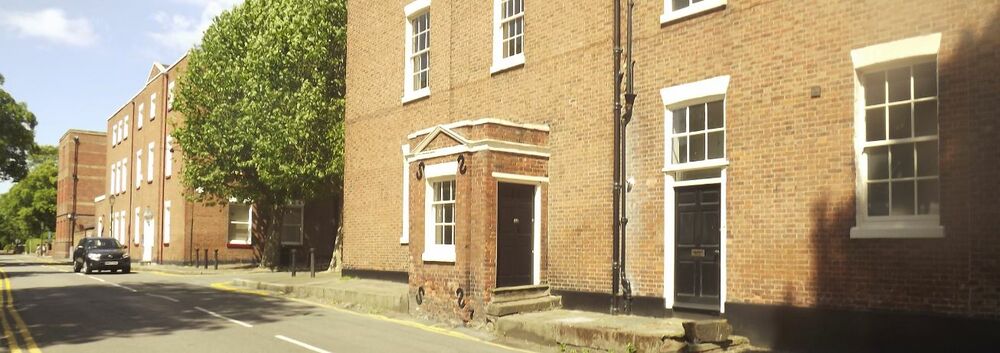
Continue along the walls, over the railway bridge to the Watertower
- Note the old Infirmary as you pass it;
- You can get down off the walls here to looks at Watergate Park and the Gloverstone;
- Water Tower on English Heritage;
- Water Tower on Wikipedia;

Head on along the walls, passing the Goblin Tower and Morgan's Mount, or (if you are collecting all the way-markers), go down off the walls and walk along the Canal
- Northgate Locks at English Heritage;
Arrive at St John's Hospital and the Northgate
The "new" Northgate was built in 1810 by Thomas Harrison.

- St John's Hospital on British History Online;
- St John's Hospital on English Heritage;
- Bridge of Signs on English Heritage;
- Bridge of Sighs on Wikipedia;
- Northgate Bridge on English Heritage;
- Northgate on English Heritage;
- Northgate on Wikipedia;
Rufus Court
- 1 Abbey Green at English Heritage;
- 1-2 City Walls at English Heritage;
Blue Bell
- Blue Bell at English Heritage;
Odeon
- Odeon Buildings at English Heritage;

Library
Those Waymarkers - what to look for
The Town Hall
The Abbey Gateway
The Abbey Square
The Bell Tower
The Eastgate
The Nine Houses (of which there are six)
The Amphitheatre
The church of St Johns
The Hermitage
The Weir and the Old Dee Bridge
The Bear and Billet
The Chester Castle Gateway
The Watertower


